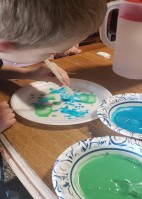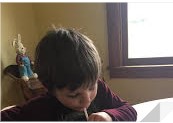Next Gen Navigator
Using Daily Dos to Make Science Accessible to Our Youngest Learners
By Maria Barthelmann and Stephanie Canale
Posted on 2020-06-25
Disclaimer: The views expressed in this blog post are those of the author(s) and do not necessarily reflect the official position of the National Science Teaching Association (NSTA).
On March 14, our kindergarten team received news that required us to quickly change gears on how we delivered instruction to our little ones. Our team did not miss a beat! We spent the weekend exchanging texts and e-mails, and creating a dynamic document that would allow us to guide at-home learning. Families instantly became the classroom teachers’ assistants.
During these unprecedented times, we were aware that our students’ families were dealing with many issues, including keeping their family healthy; maintaining a work and family balance; being furloughed; and not having an income for an indefinite period of time. As teachers, we still wanted families and students engaged in learning. We developed the following list of “Learning Criteria” to guide our work:
- Is it an essential kindergarten standard? Or could it be easily combined with a first- or second grade standard next year?
- How can we help families feel more confident in teaching science to their students at home?
- How can we make activities accessible to all students/families?
When our school closed, we had just started the kindergarten science unit on Forces and Interactions: Pushes and Pulls. The essential standards were K-PS2-1: Plan and conduct an investigation to compare the effects of different strengths or different directions of pushes and pulls on the motion of an object, and K-PS2-2:Analyze data to determine if a design solution works as intended to change the speed or direction of an object with a push or a pull.
We first consulted the teacher manual that accompanied our curriculum and quickly realized we couldn’t simply make a copy of it and send it home to families. The teacher manual included too much information to expect a family to digest and use, especially with the competing priorities at home. We needed to share information in a way that built families’ confidence! Our solution was using simple short videos that would allow students to see their teachers and build home–school connections, while providing families with instructional guidance that could be viewed and reviewed anytime at their convenience. What a wonderful way to stay connected while being distant!
We now needed to find a way to provide accessible, learning-based experiences for our students. We wanted to choose activities that used materials readily available in most homes.
The last lesson we taught our students when school was in session was about pushes and pulls. We focused on what it looks like when we push, what things can be pushed, and what happens when something is pushed softly versus when it is pushed hard. We needed a lesson that met our three criteria and maintained a consistent flow in the topic. A review of online resources led us to the NSTA Daily Dos! They were aligned to essential performance expectations, could be easily taught at home, and used material that was easily accessible. In addition, the Daily Dos offered great variety, so we could select the ones that matched the topic we were teaching.
 The “How Does Air Make Things Move?” Daily Do was the perfect fit for us! We had decided our learning experiences would start with an activity in which students used a straw (or dismantled pen) to push paint or homemade paint (flour, water, and food coloring) on a paper plate or sheet of paper. We made a Pushing Paint video to help families and students view and become familiar with the task. We found that “How Does Air Make Things Move?” built nicely from that activity.
The “How Does Air Make Things Move?” Daily Do was the perfect fit for us! We had decided our learning experiences would start with an activity in which students used a straw (or dismantled pen) to push paint or homemade paint (flour, water, and food coloring) on a paper plate or sheet of paper. We made a Pushing Paint video to help families and students view and become familiar with the task. We found that “How Does Air Make Things Move?” built nicely from that activity.
The video showing wind blowing offered an opportunity to discuss other types of pushes. The Daily Do asked students to push air through a straw to then push a variety of other objects. We were able to make a brief video in which we demonstrated this activity. We were then able to share the Daily Do’s prompts with our families; for example, How do you make objects start moving? Can you make the object move the same distance each time? How did you do it? We were most impressed with how simple it was to select a Daily Do and make it easily fit our goals and Learning Criteria.
 The feedback from families as co-educators was equally positive. Some of the comments we received were these:
The feedback from families as co-educators was equally positive. Some of the comments we received were these:
“Tyler really liked this. The concepts were well defined with the visuals. It made it really easy for him to grasp. He would comment on things being pushed and pulled (without being prompted by me) at various times after learning the lessons!”
“Lorenzo said he enjoyed the way he was able to learn about pushes and pulls. He said it was a different way of learning than at school, but he loved it. And I thought it was a great and engaging way for the kids to learn, even though it was from a home setting.”
“Benito really enjoyed the lessons and kept identifying what he had learned during his actions and activities!”
Our kindergarten team loves science, and the Daily Dos let kids be scientists and explore things on their own. This is so important!

Maria Barthelmann is a kindergarten teacher in the Greece Central School District in Rochester, New York. She attended State University of New York Geneseo, where she earned a BS in management, and later earned a master’s degree in elementary education from Nazareth College in Rochester, New York. Barthelmann returned to the classroom after raising her two children and has taught for a total of four years. She currently lives in Hilton, New York, with her husband, Fred, and her two sons, ages 16 and 19.

Stephanie Canale is a kindergarten teacher at Longridge Elementary School in Rochester, New York, in the Greece Central School District. She has been teaching for 14 years and enjoys introducing science to her young learners, believing that watching children experiment, become scientists, and figure out answers on their own is a beautiful thing. Canale has been married for nine years and has two young children.
Note: This article is featured in the June 2020 issue of Next Gen Navigator, a monthly e-newsletter from NSTA delivering information, insights, resources, and professional learning opportunities for science educators by science educators on the Next Generation Science Standards and three-dimensional instruction. Click here to sign up to receive the Navigator every month.
The mission of NSTA is to promote excellence and innovation in science teaching and learning for all.
NGSS Three-Dimensional Learning Elementary

